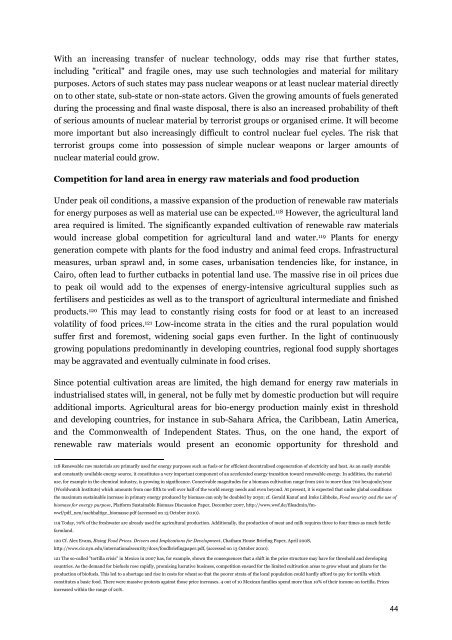PEAK OIL
PEAK OIL
PEAK OIL
You also want an ePaper? Increase the reach of your titles
YUMPU automatically turns print PDFs into web optimized ePapers that Google loves.
With an increasing transfer of nuclear technology, odds may rise that further states,<br />
including "critical" and fragile ones, may use such technologies and material for military<br />
purposes. Actors of such states may pass nuclear weapons or at least nuclear material directly<br />
on to other state, sub-state or non-state actors. Given the growing amounts of fuels generated<br />
during the processing and final waste disposal, there is also an increased probability of theft<br />
of serious amounts of nuclear material by terrorist groups or organised crime. It will become<br />
more important but also increasingly difficult to control nuclear fuel cycles. The risk that<br />
terrorist groups come into possession of simple nuclear weapons or larger amounts of<br />
nuclear material could grow.<br />
Competition for land area in energy raw materials and food production<br />
Under peak oil conditions, a massive expansion of the production of renewable raw materials<br />
for energy purposes as well as material use can be expected. 118 However, the agricultural land<br />
area required is limited. The significantly expanded cultivation of renewable raw materials<br />
would increase global competition for agricultural land and water. 119 Plants for energy<br />
generation compete with plants for the food industry and animal feed crops. Infrastructural<br />
measures, urban sprawl and, in some cases, urbanisation tendencies like, for instance, in<br />
Cairo, often lead to further cutbacks in potential land use. The massive rise in oil prices due<br />
to peak oil would add to the expenses of energy-intensive agricultural supplies such as<br />
fertilisers and pesticides as well as to the transport of agricultural intermediate and finished<br />
products. 120 This may lead to constantly rising costs for food or at least to an increased<br />
volatility of food prices. 121 Low-income strata in the cities and the rural population would<br />
suffer first and foremost, widening social gaps even further. In the light of continuously<br />
growing populations predominantly in developing countries, regional food supply shortages<br />
may be aggravated and eventually culminate in food crises.<br />
Since potential cultivation areas are limited, the high demand for energy raw materials in<br />
industrialised states will, in general, not be fully met by domestic production but will require<br />
additional imports. Agricultural areas for bio-energy production mainly exist in threshold<br />
and developing countries, for instance in sub-Sahara Africa, the Caribbean, Latin America,<br />
and the Commonwealth of Independent States. Thus, on the one hand, the export of<br />
renewable raw materials would present an economic opportunity for threshold and<br />
118 Renewable raw materials are primarily used for energy purposes such as fuels or for efficient decentralised cogeneration of electricity and heat. As an easily storable<br />
and constantly available energy source, it constitutes a very important component of an accelerated energy transition toward renewable energy. In addition, the material<br />
use, for example in the chemical industry, is growing in significance. Conceivable magnitudes for a biomass cultivation range from 200 to more than 700 hexajoule/year<br />
(Worldwatch Institute) which amounts from one fifth to well over half of the world energy needs and even beyond. At present, it is expected that under global conditions<br />
the maximum sustainable increase in primary energy produced by biomass can only be doubled by 2050; cf. Gerald Kanuf and Imke Lübbeke, Food security and the use of<br />
biomass for energy purpose, Platform Sustainable Biomass Discussion Paper, December 2007, http://www.wwf.de/fileadmin/fmwwf/pdf_neu/nachhaltige_biomasse.pdf<br />
(accessed on 13 October 2010).<br />
119 Today, 70% of the freshwater are already used for agricultural production. Additionally, the production of meat and milk requires three to four times as much fertile<br />
farmland.<br />
120 Cf. Alex Evans, Rising Food Prices. Drivers and Implications for Development, Chatham House Briefing Paper, April 2008,<br />
http://www.cic.nyu.edu/internationalsecurity/docs/foodbriefingpaper.pdf, (accessed on 13 October 2010).<br />
121 The so-called "tortilla crisis" in Mexico in 2007 has, for example, shown the consequences that a shift in the price structure may have for threshold and developing<br />
countries. As the demand for biofuels rose rapidly, promising lucrative business, competition ensued for the limited cultivation areas to grow wheat and plants for the<br />
production of biofuels. This led to a shortage and rise in costs for wheat so that the poorer strata of the local population could hardly afford to pay for tortilla which<br />
constitutes a basic food. There were massive protests against those price increases. 4 out of 10 Mexican families spend more than 10% of their income on tortilla. Prices<br />
increased within the range of 20%.<br />
44


